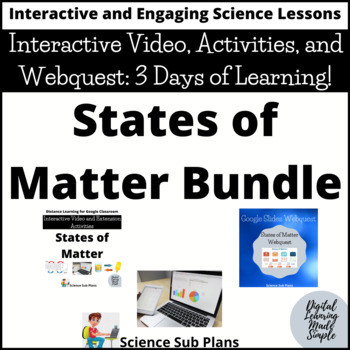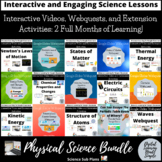States of Matter - Interactive Video, Extension Activities, and Webquest
- Google Drive™ folder
- Webquests

What educators are saying
Products in this Bundle (2)
Also included in
- 2 MONTHS OF COMPLETE PHYSICAL SCIENCE LESSONS! NO TEACHER PREP! ANSWER KEYS INCLUDED. EXTENSION ACTIVITIES TO INCREASE STUDENT UNDERSTANDING AND COMPREHENSION! SHARE THE LINKS WITH STUDENTS OR POST ON GOOGLE CLASSROOM AND LET THE LEARNING BEGIN! ONLINE PRACTICE LINKS INCLUDED. These lessons includesPrice $102.96Original Price $128.70Save $25.74
Description
3 DAYS OF COMPLETE SCIENCE LESSONS! NO TEACHER PREP!
NO TEACHER PREP! ANSWER KEY INCLUDED. SHARE THE LINK WITH STUDENTS OR POST ON GOOGLE CLASSROOM AND LET THE LEARNING BEGIN!
THIS RESOURCE INCLUDES:
- A PDF version of all documents
- A Google Doc version- Ideal for posting directly to Google Classroom
Days 1 & 2: States of Matter Interactive Video and Extension Activities
This interactive video and extension activities challenge students to explore the states of matter. Students begin their exploration by watching an interactive video to get a basic understanding of the particle movement within each state of matter and then deepen their understanding through several extension activities. This is a complete and thorough 2 day lesson/unit with absolutely NO PREP WORK for the teacher!
Lesson Overview. Students will:
- Understand the basic movement of particles within different states of matter
- Differentiate between the attractive forces of the particles within each state
- Comprehend the idea that by adding energy to a substance, the kinetic energy of the particles will increase causing a change of state
- Explain how the force between particles determines the characteristics of a given substance
- Develop a creative writing to illustrate their understanding
- Engage in discussion with classmates using higher order thinking
This resource includes:
- An interactive, highly engaging student video
- Note taking worksheet to accompany video
- Step-by-step directions and suggested timeline
- Tips to help students write higher order thinking questions for classmates
- Extension activities to deepen student comprehension
- Online practice opportunities to review concepts
- Creative writing prompt to allow student illustration/application of understanding
Day 3: States of Matter Webquest
GOOGLE SLIDES WEBQUEST! NO TEACHER PREP! ANSWER KEY INCLUDED. SHARE THE LINK WITH STUDENTS OR POST ON GOOGLE CLASSROOM AND LET THE LEARNING BEGIN!
From the webquest, students will:
- Learn about the different states of matter
- Describe the difference between the particle movement in each state of matter
- Apply learning principles in an interactive simulation
- Explain how heat energy impacts particle arrangement
- Differentiate between atoms, molecules, and compounds and how they respond to changes in state of matter
These lessons includes opportunities for both individual and collaborative learning. All learning activities can be adapted for individual learning or teamwork depending on teacher preference.
Let’s Connect!
Follow my store at this link to stay up-to-date on my latest science resources! Click here!
Follow me on social media to be the first to know about new and upcoming resources:
Instagram: Science Sub Plans on Instagram
Facebook: Science Sub Plans on Facebook
Pinterest: Science Sub Plans on Pinterest
Twitter: Science Sub Plans on Twitter
Did you know you can earn free TpT resources?
Customer Tips: How to get TpT credit to use towards future purchases: *Please go to your My Purchases page (you need to login). Next to each purchase, you’ll see a Provide Feedback button. Click that and you will be taken to a page where you can give a rating and leave a short comment about the product. Each time you give feedback, TpT gives you credit that you can use towards your future purchases






